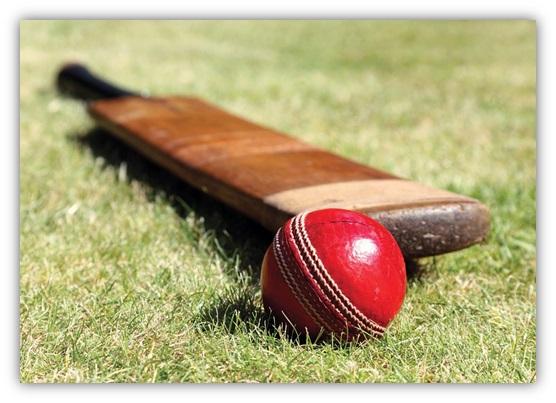I love sports, probably more than I love music. All my life I’ve played, rooted for and watched all sports available to the average American sports fan.
But what can a hard-core American sports fan do when they move to a part of the world that doesn’t follow ANY American sports?
Of course – they adapt.
My tennis experience led to squash; pickup football in the States bequeathed rugby. So what about baseball?
Enter Filthy, a passionate cricket player from Cambridge University studying Arabic in Damascus. We became fast friends, and one day he began blathering on and on about cricket. At first I was just being polite, listening to Filthy ramble on about Michael Atherton holding fort against South African fast bowling, defending for over ten hours as if he were in Dunkirk fighting the Nazis.
I had no idea what the hell he was talking about.
He brought out newspaper clips – it turns out, Filthy was a pretty decent player, and he’d played against professional clubs when at Cambridge (something entirely different in England than here, but the top universities are good enough to field teams against the pros). Funny enough, Filthy was most proud of the newspaper that actually mocked his batting efforts against the fastest bowler (think: pitcher) in England.
When I moved home in 1997, I joined a local rugby team, yet grew bored quickly. After spending two years with expatriates from around the world, I was back in Jersey with a bunch of American ex-football players. I wanted diversity. One night, after returning home from a practice, the local paper had a 3 page article on cricket in Philadelphia.
I quickly made a few phone calls, and found a club called British Officers. Neither British, nor an officer, yet there I was at a Thursday practice learning to play a sport I’d never heard of before Damascus. After practice, I went off to the pub with a few other players, each with a different background: English, Australian, South African, Indian, Pakistani, Kiwi, orthodox Jew, and even a Japanese player.
I’d found a home. And a new sport.
Cricket became the sport I was most passionate about, much like Filthy had in Syria. I was a disciplined missionary, spreading knowledge about the game to any Americans who made the mistake of giving me an ear…and mt58 has made the same mistake. So…here we go:
Cricket has a LOT of similarities to baseball, even if you wouldn’t recognize it on TV or through its terminology. For instance:
- Each team gets two innings to score the most runs AND get the other team entirely OUT before the match is over At the international level (called “Test Matches), this could take 5 days.
- Americans have difficulty appreciating a draw (“tie”), but there is IMMENSE pleasure in batting knowing the other team HAS to get you out…but can’t.
- Most amateur games are shorter than that (based on the number of pitches thrown), and a team only needs to score more runs than the other side to win.
- The batting lineup is like T-ball – everyone gets a chance to bat, 11 players per side. The game starts with the first two batters on the base (wicket), and after each out a new batter comes onto the field. After 10 outs, the inning is over.
- There are two bases in the middle of the field, and the batters can hit the ball in ANY direction. They also use bats that look like fraternity paddles, which make it easier for a batter than in baseball. A typical field is about 20% bigger than a typical baseball field, so even with two more fielders than in baseball, it is very difficult to play defense.
- Batters (or batsmen, in cricket) get out the same way they do in baseball:
- A ball caught in the air off the bat. The difference here is that the catcher (i.e., wicketkeeper) is the ONLY player in the field with gloves. A cricket ball is the same size and density as a baseball, only it’s red. This means it can hurt a LOT trying to catch line drives and high fly balls.
- The fielding team tags the base before the runner arrives. Key differences include:
- The batsman doesn’t have to run when they hit it. If they don’t think they can make it, they stay at their base.
- The “base” is the wicket; 3 wooden stumps with 2 bails across the top. In order to get the batter out, the fielding team must knock the bails off the stumps before the runner arrives.
- Oh, and the batsman carries the bat and can use the bat as an extension of their body! The batsman doesn’t “tag” the base; they merely need to cross the front line of the batters’ box. That’s why you might see a player diving with bat extended trying to touch the bat beyond the batting crease before the bails are knocked off.
- The pitcher (bowler) strikes out the batter. HOWEVER:
- A “strikeout” is only achieved if the bowler hits the stumps while pitching the ball, not through swings that miss the ball.
- The bowler only has to hit the wickets one time, not three as in baseball.
- And if the batsman puts his body/leg in front of the wicket to prevent the ball from hitting it, the umpire can call him out. It’s called, imaginatively enough, LBW (leg before wicket).
- The first time I ever played, I was out on the first ball; bowled. I didn’t get to bat again, in a game that lasted 6 hours. In the first few years I was horrible at batting, but in that time I developed a siege mentality (i.e., “Dunkirk”) and began to think of cricket as a combination of baseball and chess. As a batter, it is such a mental game.
- Let’s talk about pitching…or bowling, as they would say. The distance between the wickets/bases is 66 feet, but since the wickets are in the back of the batter’s box (batting crease), AND the pitchers can pitch from the batting crease, the distance between bowler and batsman is a little shorter than sixty feet, six inches.
- Cricket bowlers can’t bend their elbows, but they are allowed to run up to the bowling area (which is the same as the batters’ box, where the non-batting player stands waiting to run.
- Since they can’t bend their elbows, and cricket bats are flat and 4” wide, how in the hell can bowlers get them out?
- One: bounce the ball on the ground BEFORE it gets to the batsmen and get it to vary ever so slightly so the ball hits the edge of the bat and flutters nicely into a fielder’s hands.
- Two: spin the ball with a flick of wrist to get it to turn rapidly after hitting the ground.
- In yet another similarity, pitchers and bowlers generate their power using their lower body, but whereas torque is generated by pitchers in their elbow, cricket bowlers use their wrists. The power means that top pitchers/bowlers throw the ball over 90 MPH.
- Since they can’t bend their elbows, and cricket bats are flat and 4” wide, how in the hell can bowlers get them out?
Funny story: the team I played for toured Toronto every year at the beginning of July, and in 1998 I joined them for the first time. I wasn’t very good at this point; in 25 games I played I didn’t bat OR bowl in 20 of them. However, the team was short on bowlers for this trip, so our captain told me I’d need to bowl about 42 pitches per game (quick side note: substitutions are NOT allowed in cricket – all the pitchers in a game HAVE to be on the field at the beginning of the game, same as the batsmen). Bowlers take turns bowling six balls from opposite ends, called overs, so I would be needed for seven overs.
There we were, playing against Toronto Cricket Club, on a REAL ground: stands, people around the field watching, and the captain gave me the ball. I began to run up… and I forgot how to bowl! When I arrived at the crease, I wound up and threw the ball like a baseball player, and instead of bouncing the ball, I threw it right at the batsman! He ducked, the wicketkeeper couldn’t catch it, and it rolled over the far boundary. If a ball rolls over the boundary whether it’s hit or thrown, the batting team is awarded four runs (if it’s hit in the air, like a home run, it’s worth six). Worse yet, I threw an illegal pitch, which meant I still had to throw 42 balls.
Next one, same result. Then again.
I finally resorted to just standing in one place, spinning my arm over and over like a windmill before finally releasing the ball. I finished my first over of six balls, and the captain came up to me, patted me on the back, and called on another player who wasn’t a pitcher to take my spot.
It was a humbling experience, but didn’t diminish my love for the sport.
tnocs.com contributing author thegue
When I was 38, my fiancé told me she was not moving to America and our engagement was off, I became depressed. A month later on my 39th birthday, my brother told me he had contracted HIV, and my year spiraled out of control. I resigned from my job in June, and reached out to an old cricket teammate who had moved to Sydney, Australia. As I explained my life’s circumstances, he told me to come down and stay with him while I figured out my next step. In August, I packed my bags and moved Down Under. A month later, I discovered a multinational cricket team and a new home. For a year, I played cricket four times a week, and pulled myself back together.
One night after cricket practice, I logged onto Facebook and saw I had a new friend request from the older sister of a student I’d taught. She was cute, so I accepted. We didn’t talk for three years, but we liked each other’s photos, and one night when I was living back in Philly I reached out to her through social media. The next night, she stopped in at the bar where I tended bar, and a week later we went on our first date.
On May 26th, we will be celebrating our eleventh anniversary of that night.
I can promise you cricket will NOT be involved (she absolutely HATES a game that takes twice as long as baseball), but understands my passion for it, even in retirement.
After all, without it, I wouldn’t have her, or our beautiful children today.
Thanks, cricket.
Let the author know that you liked their article with a “heart” upvote!





As an Englishman and a cricket lover I wholeheartedly approve of this. Great effort at explaining the game in simple terms. Worth saying that Test matches (the 5 day games) aren’t the only format. There are also one day games with each side having 50 overs to post the highest score and in the last 15 years the 20/20 format has really taken off – each team has just 20 overs to bat so it promotes heavy hitting and fast scoring and ‘only takes around 3 hours.
One other aspect of cricket is the crowd. For international matches particularly in England and Australia big crowds show up. The Melbourne Cricket Ground hosts the Boxing Day Test every year with upto 90,000 attendees per day. The game has done quite a bit to make it more family friendly, 20/20 format in particular, but the lure of spending all day, play generally lasts from 11am to 6pm, sat in the (hopefully) sunshine drinking alcohol is a big lure. Often the crowd makes its own entertainment separate to what is happening on the field. Its generally good natured but when it comes to England vs Australia the stakes are raised and the crowd interaction, with the players as well, can get spicy.
Thanks JJ! I was hoping for your seal of approval when I wrote this.
I alluded to the shortened versions but thought that would detract from the main aspect of the story. Also, my game is better suited for the long versions – most leagues I played in were 40 over leagues, but the tournament in Philly I linked is Twenty/20, and when in Australia we played two-day games as well.
I also watched England-India at Headingly some time ago, when it was almost pitch black but Tendulkar was absolutely mauling English bowling. The umpires kept asking him if he wanted to call it an evening due to darkness and he was constantly telling them HELL NO. Finally the umpires called stumps when THEY couldn’t see anymore.
I don’t have to tell you about the most famous Headingly match as well. Dennis Lillee was the guest of honor one year at the Philadelphia tournament, among many other famous cricketers.
What are the chances?! I was also at Headingley for England v India in 2002 – think I went to 2 days though can’t remember which. At that time I lived about a mile from the ground. My main memory from that match was things got a bit boring for a while as India were grinding us into the dust and we set up to try and bore them into making mistakes. The crowd got restless and took to ripping up the free newspapers handed out on entry and performed a raucous Mexican wave while ripping up the newspapers and throwing the shreds in the air. It was like a tickertape parade celebrating tedium!
One other Headingley highlight for me was the 2001 Ashes test. I was at 4 of the 5 days. Day 1 I got so drunk I had no idea that Ricky Ponting had scored a century. Fortunately I was more cricket focused the other days. Australia made a very sporting declaration to set us 315 to win which 95% of the time back then we’d have abject failed at. Tickets were made available for the last day at £10 on the gate. I should have been at work as I’d agreed to do overtime that day but decided this was more important, called work and didn’t even bother making an excuse, said I was off to the cricket instead. As it was only overtime rather than my scheduled day they didn’t hold it against me thankfully!
Walked into the ground to the sound of groans as Atherton was out first over but then another Headingley miracle unfolded as Mark Butcher played the innings of his life with 173 not out to see us to victory. We still lost the series 4 – 1 and to be honest we were outplayed on 4 of the 5 days of the match we won. That’s the beauty of sport though!
And special mention to the one that got away. We had tickets for day 3 of the England v West Indies Headingley test of 2000. Kept track online in horror as scoreboard carnage unfolded with both teams showcasing such batting ineptitude that it became the first test match in over 50 years to end within 2 days. We got a refund for our unused tickets minus 20% of the cost as an admin fee as a further kick in the teeth. At least England won the match.
I don’t know if there’s anyone who’s more sports-illiterate than I am. For instance: For most of my life I thought that a “crumpet” was some arcane term used in cricket, because of a very American-centric taunt about cricket in the 1990 Ninja Turtles movie that I had seen as a kid: “No one understands cricket! You gotta know what a crumpet is to understand cricket!” Alas, I didn’t realize was a joke until I had learned a bit more about British baked goods. 🙂
Great write-up! I learned more today than ever before!
Splendid write-up thegue… My entire knowledge of how cricket is played comes from Monty Python sketches, so it’s good to have some sort of clarification (even though I’m still lost… I think I just need to bite the bullet and watch some actual matches).
https://www.dailymotion.com/video/x6dl8og
There’s a great book that compares the two as well: Ed Smith’s “Playing Hard Ball”. He was a professional cricketer who broke his wrist and went to Florida to get back into shape by going through spring training with the Mets (he somehow knew the Wilpons).
He’s become a bit of an author, as well as one of the selectors for the English national side…and a former teammate of the aforementioned Filthy.
Thanks, thegue, for explaining a sport that’s beloved the world over and totally misunderstood here. I was particularly struck by the happy ending.
As mt58 would say, good on you both.
After my college football career came to a halt, I’ll talk about my love affair with rugby when I get a chance.